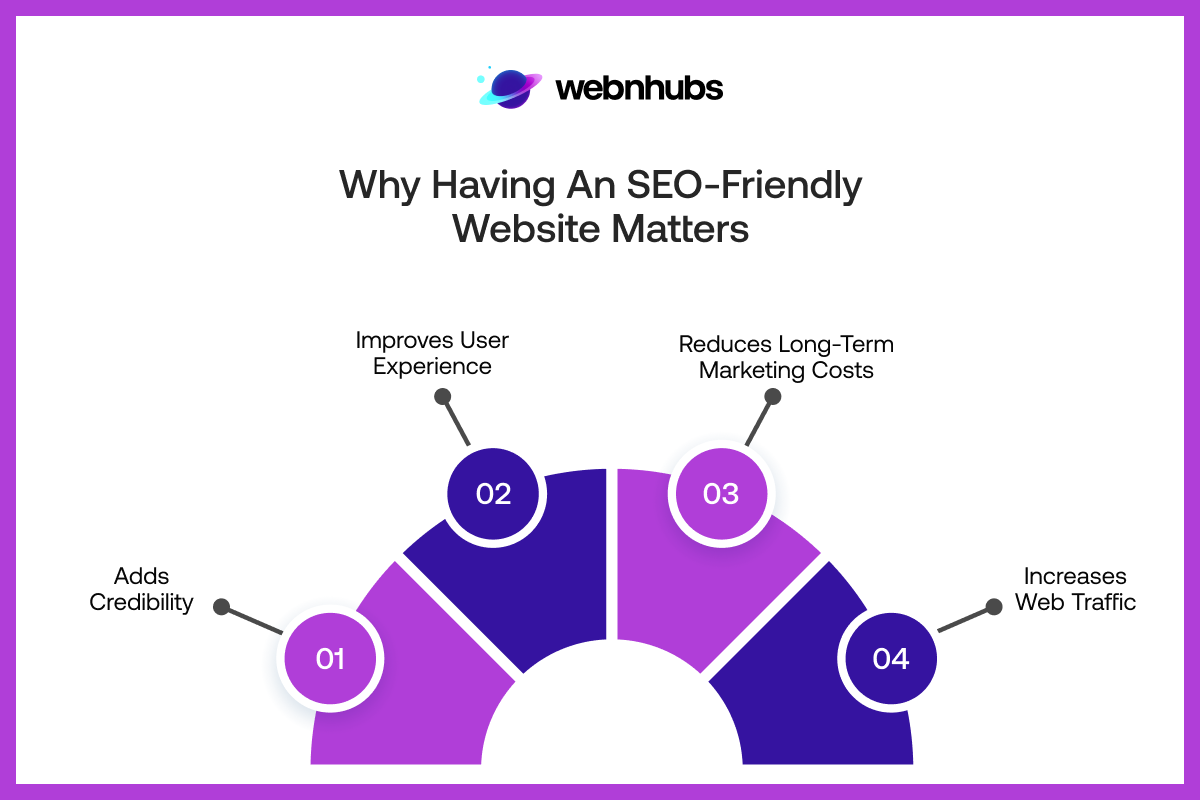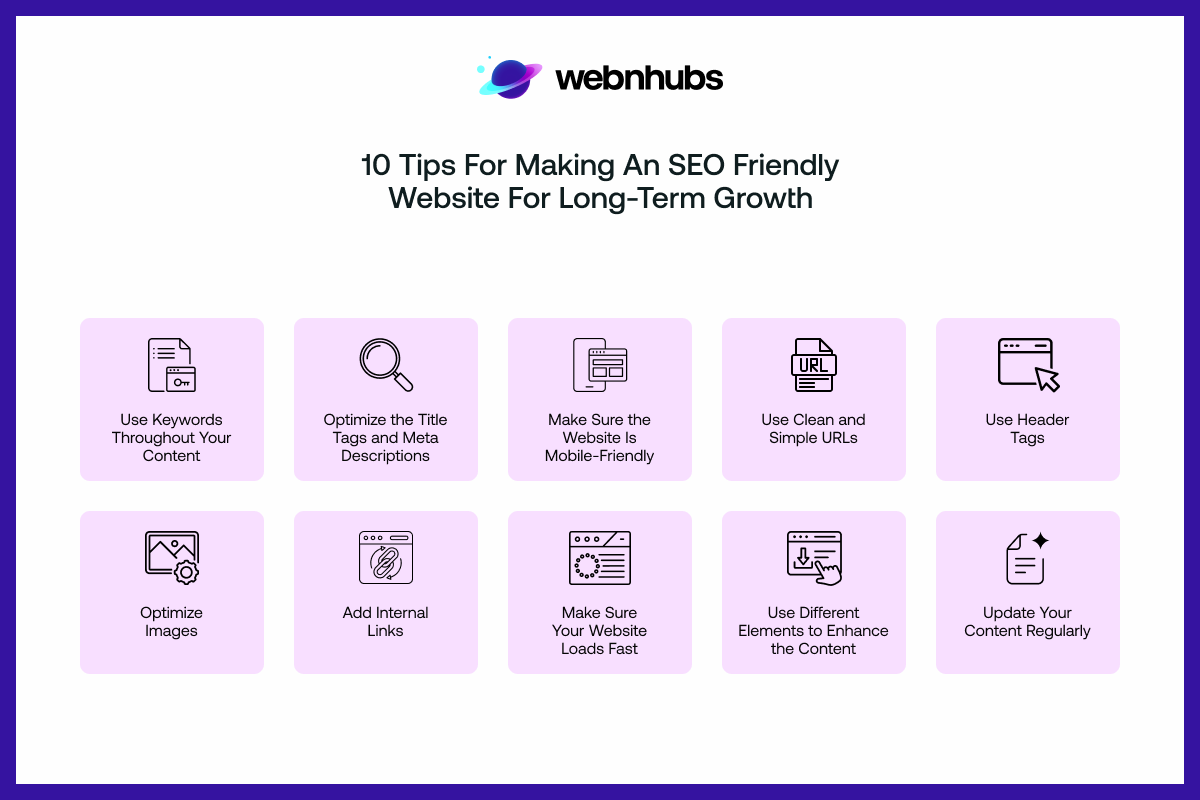
Search engine optimization, or SEO as the pros like to call it, is the heart and soul of a website. Without SEO, a website is lifeless and as good as dead.
It’s akin to the gate of a shop that allows customers to walk in and buy from that store. However, websites by birth are not SEO friendly.
As a matter of fact, in many cases, even an SEO friendly website can become non SEO friendly if it’s not looked after.
Therefore, it goes without saying how important SEO is for a website and an eCommerce business as a whole.
And in today’s day and age, having an SEO friendly website qualifies you to enter the race of getting sales and leads with millions of websites participating in the said race.
So, what makes a website search engine friendly, and how can you do the same with yours?
To find that out, I will talk about the tips and practices that can make your site an SEO friendly website.
So, without any further ado, let’s get right into it.
Why Having an SEO-Friendly Website Matters

An SEO compatible website is a golden ticket to your business success. We already know how important an eCommerce Website is to a business.
And the same could be said for SEO and the importance it holds for a site. SEO makes your site eligible to enter this competition on the internet. It’s a race in which every other site is after the same visitors and customers as yours.
And if you do justice to the SEO friendly meaning, which is being technically sound, delightful to use, and search-focused, then you can get ahead of the competition and emerge as the winner.
But how exactly important is it to have SEO for your site? Well, the following are the reasons why you need to get on board with SEO requirements for the new website.
And if you do, then your site can win and be among the best SEO optimized websites. These reasons are as follows:
Adds Credibility
SEO is just a complete starter pack to landing on user expectations and fulfilling them. It allows your site to keep up with industry and tech trends.
And when a site does that, it fulfills the SEO-friendly meaning by becoming legit, credible, and trustworthy.
This credibility not only allows customers to place their trust in you but also makes your site trustworthy in the eyes of search engines.
Want to Boost Your Site Rankings With SEO-Friendly Design?
Let Webnhubs Create a Site that Performs and Converts!
Improves User Experience
SEO is for the benefit of internet users as much as it is for your site and its rankings. To better understand what does SEO friendly mean, you have to know why it exists in the first place.
Well, if you haven’t already figured it out, then SEO makes your site meaningful, purposeful, and above all, helpful.
This means everything from content to web design with SEO and web pages all serve a purpose; they cater to user needs.
And that is what the whole user experience is all about, and SEO, my friend, enhances the Website User Experience.
Reduces Long-Term Marketing Costs
If you know how to incorporate SEO into website, then congratulations, you have saved yourself a fortune.
That is because having the best SEO page is more cost-effective in the long run than a page promoted via paid ads or any other marketing campaign, for that matter.
Brands use many Website Marketing Strategies to bring in visitors, and rightfully so. While each marketing strategy has its ups and downs, none is more affordable than SEO.
And not to forget, each of those strategies, whether paid or unpaid, pale in comparison to the results that SEO friendly web design provides.
So, if you know how to do SEO on your own website, then you can save thousands of dollars in marketing costs down the line.
Increases Web Traffic
SEO is all about making website searchable and visible on the SERPs. If you know how to add SEO to website HTML and do it right, then you can make your site discoverable on the internet.
The internet is flooded with billions of sites. So, it is already difficult enough to appear on a user’s search results, let alone bring that user in.
But if you do justice to SEO and know how to add SEO to my website, then you can use various SEO strategies like Content Marketing and target keywords to bring visitors to your site.
10 Tips for Making an SEO Friendly Website for Long-Term Growth

As a site owner, it is your responsibility to conduct SEO when building a website or managing it, for that matter.
And it starts from doing Website Design for SEO, all the way to publishing content and whatnot.
So, here are 10 tips that you can use for search engine friendly website design to SEO friendly website development, and just managing the site after launch.
These tips will turn your regular site into an SEO friendly website that will appear in SERPs and rank on top. They are as follows:
1. Use Keywords Throughout Your Content
One of the best ways to create an SEO optimized website example is to use the right keywords in the right places. In most cases, that place happens to be a blog.
A blog itself needs to be rich with content that is full of quality, provides insights, addresses users’ needs, and is just helpful.
And if the blog is people-first and has a good readability score, then it can be used for SEO. How come, you might wonder?
Well, one of the bases of SEO is keywords, and those keywords are incorporated in blogs naturally, logically, and strategically.
This means the keywords should not feel out of place. They must go with the flow of the sentence and fit right in.
You will need to research keywords and consider their volume and difficulty to use them in your content.
But once again, you must use keywords that make sense and use them in your content in a way that feels right.
It must not feel or look like you are targeting keywords just for the sake of using them with no regard to their effect on the content’s readability.
You must also avoid stuffing too many keywords into your content. After all, no one likes a site that is just full of keywords rather than content to help users.
And as for using keywords for one page website SEO friendly Landing Page that Converts, perhaps, their quality will matter more than their quantity.
2. Optimize the Title Tags and Meta Descriptions
The other tip for an SEO friendly website is to focus on technical SEO, most specifically title tags and meta descriptions.
If you are wondering how to build a search engine for your website, then these two are a great way to do that.
Both of these are HTML elements that add context behind the content of a site. A title tag appears as a clickable headline on the result page of a search engine.
That is why you must make sure your title tag is the same as your page title. Also, make sure your title tag includes the content’s main keyword.
On the other hand, every single web page on your site must have a meta description.
A meta description gives both users and search engines a hint into what the said page is about and what users can expect to find on it.
Ready to Drive Traffic with an SEO-Friendly Website?
Our Experts Know How to Design Sites that Rank Well.
3. Make Sure the Website Is Mobile-Friendly
Next up is a Mobile Friendly Website Design. And going for an SEO web design that is optimized for mobile is one of the best SEO tips by a mile.
After all, the world of the internet is dominated by mobile devices. And that is why the importance of making websites mobile-friendly cannot be overstated.
As per Statista’s Report, “More than 62.54% of the global web traffic comes from mobile devices in the second quarter of 2025.”
So, that stat alone tells you all you need to know about how vital it is to use mobile and SEO friendly web designs.
And that not only helps you cater to a vast majority of mobile users, but it also helps your SEO.
After all, if most people are surfing the web on their phones, then considering them is part of SEO, right?
4. Use Clean and Simple URLs
Your web page addresses (URLs) matter. They are much like your home address. Think of this: if you had to write a complicated address rather than just street name and house number, it would confuse everyone, right?
The same goes for search engines and visitors. Doing SEO for personal website means taking care of all aspects of SEO, from design to content and URLs.
That is why you will need to use URLS that are relevant to the page and, most importantly, are simple and easy to read.
This will allow search engines to index your pages faster and make it easy for users to click on the pages that appear in search results.
Sometimes, it’s not about using the most fancy Website Features, but rather getting the basics right. And that is what SEO is all about.
This is one of those tips that helps create the best SEO website examples. It helps make the obvious known and get it right when most eyes fail to see it.
5. Use Header Tags
Another way to make your site an SEO friendly website is by using header tags. Header tags are crucial as they assign heading roles. These roles are HTML elements like <H1>, <H2>, <H3>, and <H4> to your content.
They are utmost vital for blogs. Search engines are no different than the user, as both want to know which subheadings fall under which main heading and which ones stand out as their own.
Header tags make it easy for search engine results to scan your page headings. Also, when you are at it, create headings with keywords included in them.
This helps your website’s overall SEO and makes your heading more relevant. And if you use a Content Management System like WordPress on your site, then assigning heading title tags is quite easy.
6. Optimize Images
Webdesign & SEO go hand in hand. You cannot have one without the other. And in many ways, if you take care of the design and go for an SEO web site design, then you are doing SEO for your website, albeit just not with content.
But what does design for SEO mean? Well, it means avoiding all the Website Design Mistakes that make a site look bad and make it difficult for visitors to use your site.
And what other element plays a more important role in shaping a web design than images? Not many, I reckon.
That is why your images need to be on point. This means when your Graphic Designer creates infographics, illustrations, and other images for your site, they must be relevant, purposeful, and meaningful.
But more so, those images must be optimized for SEO website designs. This means they must be in the right format, small in size, so that they don’t slow down the site.
More so, you must use Alt Text for your images as it helps website SEO design.
7. Add Internal Links
Internal linking pages with one another is one of the best ways to do SEO for your site. More so, interlinking pages establishes a site architecture. It spreads link juice to all the pages on the site.
But how do you do so? Well, you use hyperlinks on your SEO home page, blogs, and service pages, most especially on words that have different page topics based on them.
For instance, if your site offers graphic design services like Webnhubs does, then you can write a blog on a topic about design principles.
And in the said blog, you can mention the different design principles, among which include White Space.
And if you happen to have a dedicated blog on the White Space topic alone, like we do, then you can hyperlink its URL in the design principles blog.
More specifically, you will need to add the hyperlink to the term “white space” that you will be discussing as one of the design principles.
Also, did you see what I did there? I just used hyperlinking for this blog. And this is how you can do it for yours as well to make your site an SEO friendly website.
8. Make Sure Your Website Loads Fast
People often ask which type of website is good for SEO purpose? Well, the answer to that question is quite simple: the one that loads fast.
There is nothing worse on the face of the internet than a site that loads fast. Whether you are learning how to make a search engine website or an eCommerce site, there is one thing you cannot get wrong, and it is your website speed.
A slow website is by far the one thing what should you avoid when developing a search optimized website.
A website that loads instantly and is lightweight is the best website for SEO. But how do you achieve that speed?
Well, first of all, you remove everything that is unnecessary. That means any features, pages, blogs, or forms that are slowing your website down must be thrown out of the gate.
Next up, you must optimize every visual aspect of your site, meaning you must optimize your Brand Logo, images, and use smaller files for upload.
And if you are using videos on your site, you must host them on a third-party website and embed them on your site.
This will free up lots of space and make your site light and fast, which is nothing but music to the ears for both visitors and search engines.
9. Use Different Elements to Enhance the Content
Another way to improve your site’s SEO is to make your content unique. But how do you do that?
Well, you use different elements and incorporate them into your content. A log gives you the room to play around with words and experiment with different elements.
So, which elements can you add to your blog? Well, first off, you follow the basics, which include bullet points, numbered lists, and tables.
But then you take things to another level by adding graphs, charts, statistics, and embedding videos and social media posts.
More so, you will need to use the same philosophy for webdesign SEO and apply it to the visual elements, too. This means you will need to use infographics, illustrations, and graphs.
And heck, you can even use doodles, too. That is because there is a whole world of Doodle Meanings.
And let me tell you, doodles do their magic like no other, and they will sure do their magic in terms of web design for SEO.
These are some of the ways that you can enhance your content. However, keep in mind that being unique does not mean you should compromise on content quality and readability.
As a matter of fact, it means your content’s style and uniqueness should equate quality.
Looking for Long-Term Growth Through SEO?
Partner with Webnhubs to Conduct SEO for Your Site
10. Update Your Content Regularly
Last but not least, the SEO tip that needs no telling, as it is a no-brainer, but I will say it anyway, is updating your content from time to time.
Yes, that’s right, updating your content improves your SEO. And given how basic this thing is, most people fail to update their content.
What updating your content for SEO for homepage and blogs does is that it allows you to update links. This way, you can remove the ones that are 404 and replace them with working links. More so, you can update stats and see more recent and relevant stats.
Also, this gives you an opportunity to add new and trending keywords to give your content a boost in energy.
More so, you can update information and the year mentioned in the content so that it is up-to-date with the current date.
So, all of these are the things you can achieve by just updating your content. And it is safe to say this will definitely improve your site’s sEO.
Get Started With Webnhubs to Create an SEO Friendly Website

Conducting SEO on a site is not a one or two-time job, nor is it a matter of hours. Instead, doing SEO properly takes time and patience.
This is where Webnhubs thrives. We are a website design and development agency that knows the ins and outs of search engine optimization.
We are a SEO friendly website builder who does it professionally and personalizes it to your liking.
More so, we offer SEO Services to improve your site’s SEO. We will help it rank on top of search engine result pages.
Whether you want us to redesign your site with SEO in mind by following a Website Redesign Project Plan or conduct SEO for an existing site, we’ve got you covered.
We have a team of digital marketers and SEO specialists who research and target keywords. More so, they create an SEO strategy to get the wheels moving for your site.
Our goal is to make your site an SEO friendly website. So, partner with Webnhubs and let us do your site’s SEO heavy lifting. We will make your site searchable, visible, and discoverable on the internet.
Wrapping It Up
So, there you have it; that is all for this blog on SEO friendly website. I hope that the SEO tips I shared in this blog can help you out. These tips will make your site an SEO friendly website. More so, you can look at some of the top SEO website examples on the internet. This way, you can get an idea of what they are doing right that makes them stand out.
The top websites that rank are following the best practices that I shared in this blog. And if you too want to make your site rank on top and need the help of a website builder SEO friendly agency to do so, then you can consider Webnhubs for the job. We are a website builder SEO agency that will conduct your site’s on-page and off-page SEO to improve its rankings.
Frequently Asked Questions
Before launching, ensure that your site is fast, mobile friendly and does not have broken links. Check your HTTPS (SSL), establish Google Search console and generate XML sitemap. Check all page title, meta tags and URL. Consider it your pre-launch SEO health check.
Do a small inspection of your site after every few months. Repost the old blogs, change keywords and repair broken links. Trends in search shift very quickly and hence an updated content keeps you visible. You do not necessarily need big changes every year but small ones.
Lightweight formats should be used; that is, WebP images and MP4 videos. Minimally store files of less than 200KB. Reduce the size of images without any quality loss with TinyPNG or HandBrake. The goal? A web site has a beautiful appearance and loads in seconds.
Make navigation easy, users (and search engines) must access any page in three clicks or fewer. Employ simple menus, logical classifications, and internal links in order to relate to related pages. A neat layout enables users to navigate without difficulties and enables Google to know more of what you have to offer.
First, repair what is broken – slow pages, broken links, or missing meta tags. After that, update old material and insert keywords naturally. Optimize your pictures and refresh your site map. There is no necessity to redesign, just an ongoing improvement of speed and clarity.
